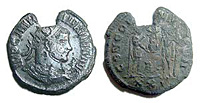 |
|||||||||||||||||||
 |
|||||||||||||||||||
 |
|||||||||||||||||||
 | |||||||||||||||||||
| Objects may have multiple functions—some more obvious than others. The primary function of an object is that for which it was originally made and used. Additional uses, however, may have been invented. A chair made for sitting could be used to reach a high object. A chair could also have a symbolic value, such as a throne. In the chair's use as furniture, its design could have social significance in the interior decoration of a house.
When meeting a new object, we often try to establish its function based on our own experiences, and often such analogies are accurate. These experiences may be misleading, though, especially when the object comes from a culture far removed in place and time from our own or was found in an environment far removed from its place of origin. The function of a coin may seem obvious—it is used in financial transactions. Coins, however, also have symbolic value connected with national identity. Coins have images of presidents or rulers, national monuments, and inscriptions such as “In God We Trust.” Historically, some coins were more important as symbols than for their monetary value, especially if the latter was so high that few circulated or were used for commerce.
Close observation of an object and its context can help establish function. Studying wear patterns, for example, may show if a knife was used or decorative, how it was held, and whether the user was left-handed or right-handed. Observing the context in which the object is found is also important. A complex around a hearth with bones of domesticated animals and implements related to the functions of preparing and consuming food might help identify otherwise "anonymous" objects as being connected with the same function.
It is always possible that an object is not in its “natural” environment, so looking for patterns or multiple examples of the same object can help determine normal use. Such examples may reveal subtle differences over time and space for drawing conclusions about societal change and interaction. Occasionally an object whose function seems obvious appears in a place where it makes little sense, prompting a re-evaluation. One sample analysis discusses the importance of numbers when understanding Byzantine coins and trade. | ||||||||||
|
finding world history | unpacking evidence | analyzing documents | teaching sources | about |
||
 Cultures that do not use coins in trade may value them as symbols of social status—for example, as jewelry. Sometimes clues about such usage are found in the coins themselves, for example, a hole at the top of a coin worn as a necklace.
Cultures that do not use coins in trade may value them as symbols of social status—for example, as jewelry. Sometimes clues about such usage are found in the coins themselves, for example, a hole at the top of a coin worn as a necklace.